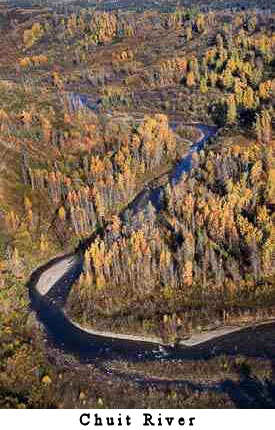
In January of 2011, the Alaska Department of Natural Resources (DNR) held a series of hearings to address a petition requesting protection for the salmon streams that would be permanently destroyed by PacRim's proposed Chuitna coal strip mine.
This petition was not a "new" regulation suddenly thrown in the way of development; state and federal coal mining laws allow citizens to submit a legal petition to regulators, asking them to declare certain lands "unsuitable" for coal strip mining. Where is it more unsuitable in Alaska to strip mine then through a salmon stream?

To begin with, let's look at Pac- Rim's proposal. They intend, for the first time ever in Alaska, to destroy a salmon stream by strip mining for coal. They will dig an enormous pit over a period of 25 years and remove 12 million metric tons of coal and overburden per year over the life of the mine. They claim that they can, somehow, restore the stream to its former productivity after mining is done and that all will be well with this salmon-bearing tributary of the Chuitna river.
The basis of the objection to this mine is the precedent that would be set. If PacRim is allowed to completely remove this salmon stream that the Department of Fish and Game considers important habitat, then the road is paved (literally) for similar mine proposals anywhere in the state. If you can mine through this salmon stream, you can mine through any salmon stream.
PacRim's proposed mine would necessitate diverting water from existing salmon spawning and rearing grounds to an adjacent watershed, then ripping up 11 miles of stream to get to the underlying coal. What effect this would have on fish seeking their ancestral waters, both for the diverted stream and the newly created "watershed," are unknown but it is safe to assume that the new flow would not smell like either of the streams as they exist now.
This mine would not benefit Alaska's energy needs, as the coal is going to China. Of course, the Chinese have plenty of coal; they are just smart enough to save theirs for when there is a shortage, and as long as we are willing to go for the fast buck, their stockpiles are secure in the ground.
PacRim is proposing a mine with a 25-year life, exporting 12 million metric tons of coal per year, 300 million tons overall. Of course, that is for just one of three mine sites, and should they be allowed to go through with the plan the numbers will be much greater.
So, how exactly does PacRim expect to remediate the riparian watershed that the mine will destroy? How can it be restored in any way, shape or form?
Twelve million tons of coal translates to roughly 7 million cubic yards of removed fill every year. That represents a hole 10.6 miles long, 300 feet wide and 30 feet deep ... annually.
This alone should render the idea of this mine as totally unfeasible; there is no way a hole that size can be reconstructed as a salmon stream. This is akin to saying a six-layer wedding cake can be moved from one room to another with a spoon, then brought back and reassembled.
As an Alaska hunter and fisherman, I urge all Alaskans to be aware of Pac- Rim's shortsighted, irresponsible mining plan and avail themselves of the opportunity to send in comments to Governor Parnell in opposition to this proposed mine.
Return to our Chuitna Taking Action page.
|
.jpg)


.jpg)
.jpg)
.jpg)
.jpg)
.jpg)
.jpg)
.jpg)

